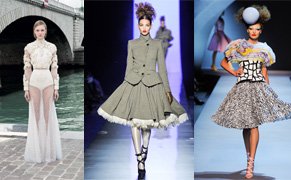Haute couture aesthetic, a term originating from the French phrase for “high sewing” or “high dressmaking,” epitomizes the pinnacle of fashion design. More than just clothing, haute couture is an art form that represents the zenith of craftsmanship, creativity, and exclusivity. It is a world where fashion transcends utility and becomes an expression of artistry and individuality. This article delves into the aesthetic of haute couture, exploring its history, characteristics, and the elements that distinguish it from other forms of fashion.
A Historical Overview
The history of haute couture aesthetic dates back to the mid-19th century, with Charles Frederick Worth often credited as the father of haute couture. Worth, an English designer, established the first haute couture house in Paris in 1858. His innovative approach included using live models to showcase his designs and creating seasonal collections, setting the standards for modern fashion shows.

The late 19th and early 20th centuries saw the rise of other iconic designers like Paul Poiret, Coco Chanel, and Elsa Schiaparelli, who further defined and expanded the boundaries of haute couture. These designers introduced revolutionary ideas, such as Poiret’s freeing of women from corsets, Chanel’s elegant simplicity, and Schiaparelli’s surrealist influences. Each contributed to the evolving aesthetic of haute couture, blending tradition with innovation.
Defining Characteristics
- Exclusivity and Customization Haute couture garments are made-to-measure for individual clients, ensuring a perfect fit. This exclusivity is a hallmark of haute couture, distinguishing it from ready-to-wear fashion. Each piece is unique, crafted to the client’s specific measurements and preferences, often involving multiple fittings and intricate adjustments.
- Artistry and Craftsmanship The creation of haute couture pieces requires exceptional skill and craftsmanship. Artisans, often referred to as “petites mains” (little hands), work meticulously on every detail, from hand-sewn seams to elaborate embroidery. Techniques such as pleating, beading, and appliqué are executed with precision, making each garment a work of art.
- Innovative Design Haute couture is synonymous with innovation and creativity. Designers push the boundaries of fashion, experimenting with new materials, silhouettes, and techniques. This innovation is not limited to aesthetics but also includes the use of cutting-edge technology, such as 3D printing and advanced textiles, to create futuristic and avant-garde designs.
- Luxurious Materials Only the finest materials are used in haute couture. Fabrics like silk, satin, tulle, and chiffon are common, often sourced from the best mills in the world. These materials are complemented by luxurious embellishments, including Swarovski crystals, pearls, and intricate lace, elevating the garments to the level of high art.
- Timelessness While haute couture embraces innovation, it also respects tradition. Many haute couture houses maintain archives of their past designs, drawing inspiration from their heritage while infusing contemporary elements. This balance between tradition and modernity ensures that haute couture remains timeless and relevant.
The Process of Creation
The creation of a haute couture piece is a labor-intensive process that involves several stages:
- Design and Inspiration The process begins with the designer’s vision, often inspired by art, history, nature, or personal experiences. Sketches and mood boards are created to conceptualize the collection, reflecting the designer’s artistic narrative.
- Pattern Making and Toile Creation Once the designs are finalized, patterns are created. A toile, or mock-up, is made using muslin or another inexpensive fabric. This step allows the designer to refine the fit and silhouette before cutting the actual fabric.
- Fabric Selection and Cutting The chosen fabrics are meticulously cut by hand, with great attention to detail. This step requires precision, as any mistake can ruin the entire piece.
- Sewing and Assembly The cut pieces are then sewn together by skilled artisans. This stage involves various techniques, such as hand stitching, draping, and fitting, to ensure the garment fits perfectly.
- Embellishment and Finishing The final stage involves adding embellishments, such as embroidery, beading, and appliqué. This step is incredibly time-consuming and requires exceptional skill, often taking hundreds of hours to complete.
- Fittings and Adjustments Multiple fittings are conducted to ensure the garment fits flawlessly. Adjustments are made as needed, with the final fitting ensuring that every detail is perfect.
The Role of Haute Couture in Modern Fashion
In the contemporary fashion landscape, haute couture occupies a unique and revered position. While the number of haute couture clients is limited, the influence of haute couture extends far beyond this exclusive circle. Haute couture collections often set trends and inspire ready-to-wear lines, shaping the direction of fashion on a global scale.

Moreover, haute couture serves as a platform for designers to showcase their creativity and vision without the commercial constraints of mass production. It is a celebration of fashion as an art form, where designers can experiment and innovate freely.
The survival of haute couture in the modern era is also a testament to its adaptability. Many haute couture houses have embraced digital technology, using virtual reality and augmented reality to create immersive fashion experiences. This fusion of tradition and technology ensures that haute couture remains relevant and captivating to new generations.
Iconic haute couture aesthetic
Several haute couture houses have left an indelible mark on the fashion world. Among them are:
- Chanel Founded by Coco Chanel, the house of Chanel is synonymous with timeless elegance and sophistication. Karl Lagerfeld, who took over as creative director in 1983, continued Chanel’s legacy while infusing modern elements into the collections. Today, under Virginie Viard, Chanel continues to captivate with its classic yet innovative designs.
- Dior Established by Christian Dior in 1946, the house of Dior revolutionized fashion with its “New Look,” characterized by cinched waists and full skirts. Subsequent designers, including Yves Saint Laurent, John Galliano, and Maria Grazia Chiuri, have each contributed to Dior’s enduring legacy of opulence and innovation.
- Valentino Known for its romantic and luxurious designs, Valentino, founded by Valentino Garavani, has become a symbol of Italian elegance. The brand’s use of rich fabrics, intricate embroidery, and signature red gowns has made it a favorite among celebrities and royalty.
- Givenchy Founded by Hubert de Givenchy, the house of Givenchy is renowned for its refined and elegant designs. Givenchy’s collaboration with Audrey Hepburn, who became a muse for the brand, solidified its place in fashion history. Today, Givenchy continues to impress under the creative direction of Matthew M. Williams.
Conclusion
The haute couture aesthetic is a celebration of artistry, craftsmanship, and individuality. It is a world where fashion transcends its functional purpose and becomes a form of artistic expression. Haute couture’s history, characterized by innovation and tradition, continues to influence and inspire the broader fashion industry. As long as there is a desire for beauty, creativity, and exclusivity, haute couture will remain an enduring and revered aspect of the fashion world.











